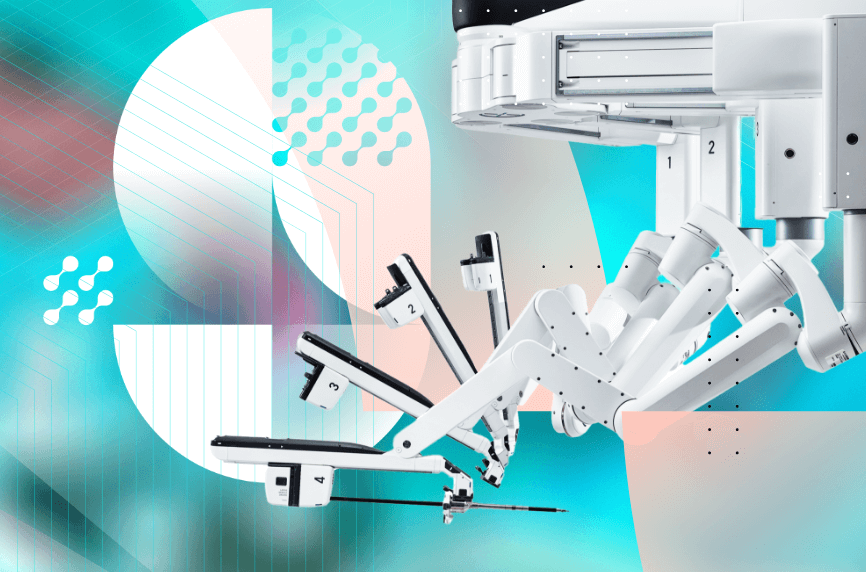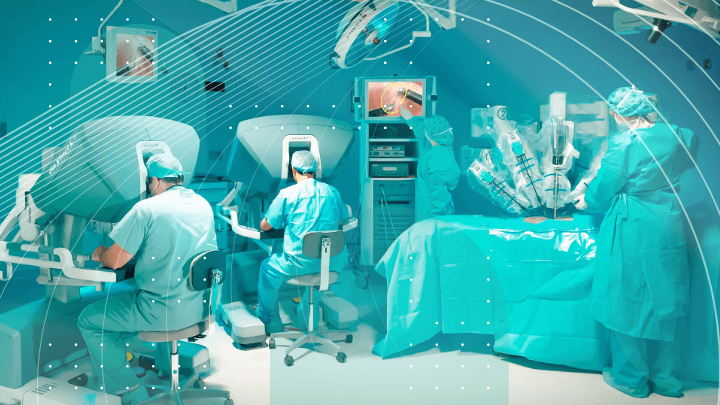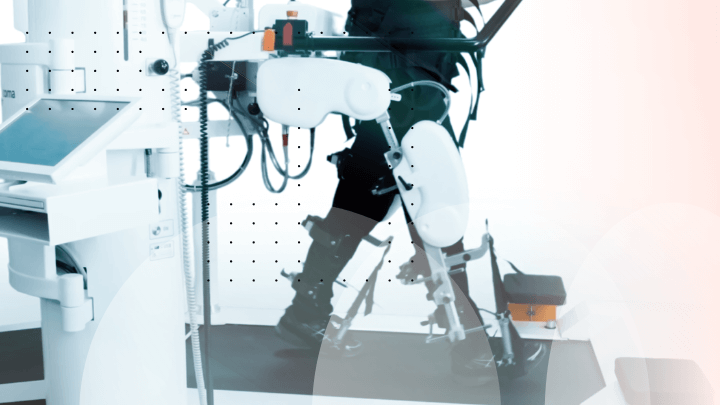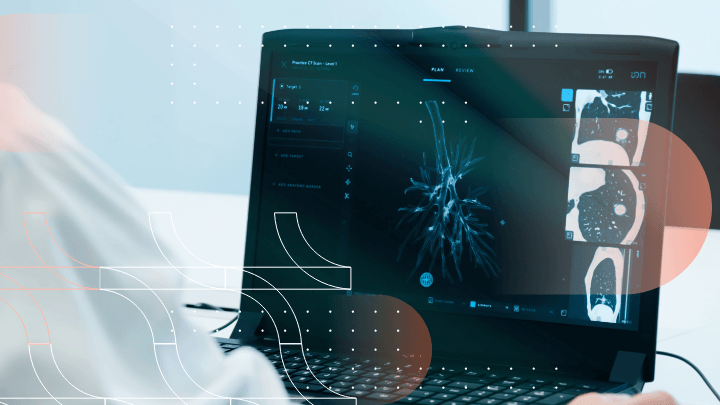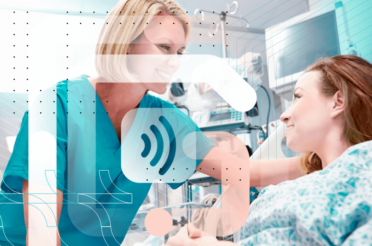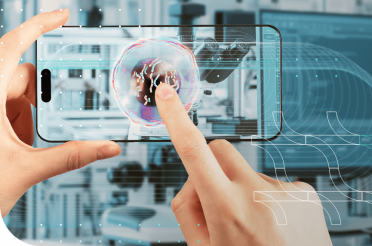In recent years, innovations in the medical field have been integrating robotics more and more into healthcare, bringing new possibilities for precision, efficiency, and innovation.
Healthcare organizations increasingly adopt robotics in their fields. Medical robotics is going to play a great role in meeting the needs of both patients and healthcare professionals as the demand for high-quality care continues to grow.
From performing routine logistical tasks to realizing treatment regimens and minimally invasive procedures, robots are doing it all! This article explores the diverse applications of robotic technologies as healthcare tools.
Robotics in surgical procedures
The new era of surgery relies on the progress of minimally invasive surgery (MIS). This includes minimizing the incision size, blood loss, and post-surgical pain. MIS stimulated the development of robotic surgical systems (RSS) that eliminate human error, e.g. hand tremors. [1]
There are some of the RSS used in healthcare:
- Da Vinci Robotic Surgical Systems – the infamous da Vinci system is used in many surgical procedures. Since its commercial launch in 2001, it has been used in more than 10 million cases in different categories: transoral, general, thoracic surgery, urology, and gynecology. These surgical robots improve significantly clinical outcomes as there is less blood loss, shorter hospital stays, and less opioid use. The future trends include the advancement of telemedicine surgery. Currently, a nephrectomy has been safely performed with a distance between the surgeon and patient of 187 km. [2]
- MAKOplasty software – this robot-assistant software is used for guided knee replacement. The system analyzes preoperative CT images and creates a 3D image. MAKO can also measure the bone resection depth, size, rotation and alignment. The image is calibrated to the patient’s anatomy and is a modern example of a personalized medicine tool. [3]
- ROSA knee system is another representative of the surgical assistance robots and is for guided knee replacement. It uses 2D X-rays that are transformed into 3D models. Then the robotic arm holds the guide in the accurate places and the surgeon is active and performs the cuts. This is the so-called collaborative mode of the robot. ROSA provides a symbiotic relationship between the robot and the surgeon. [4]
- CyberKnife is a technology for robotic-guided radiosurgery. It aims to deliver a high dose of radiation into the tumor non-invasively. The system has sub-millimeter accuracy which allows curing brain tumors as well as any other types of cancer in the body. [5]
Versius surgical robotics system is another robotic approach for laparoscopic surgery. It is used in abdominal surgery, allowing flexible positioning of the port and reusable surgical instruments. [6]
Automation in patient care
Automation in healthcare includes not only surgery but also patient care, treatment, and diagnostics. The latest trend is the integration of artificial intelligence and medical robots.
There are different categories of patient care-related robotic technologies:
- Therapeutic assistance robots;
- Nursing assistance robots;
- Rehabilitation robots;
- Telepresence robots;
- Logistics and sanitation robots.
For example, Cardiopulmonary resuscitation (CPR) robots are developed for treating patients in intensive care units. The robots eliminate the need for mechanical and manual CPR machines, decreasing the healthcare professional’s workload. The CPR robot analyzes the patient’s condition and performs life-saving protocols when needed.
Nursing care robots are another trend. They allow delivering medications timely and carrying through various tasks. This results in decreased stress of the medical staff and improved patient experience. Nursing robots have multiple functions, e.g. they can draw blood effortlessly from the patient’s body.
Moreover, sanitation and disinfection robots relieve the effort of repetitive tasks of cleaning hospital rooms. By doing this they manage to reduce the hospital-acquired infections. [7]
Telemedicine and robotics integration
Telemedicine is implemented with electronic information and communications technologies (for example robots) to provide and support health care when there is a distance between the participants.
Telepresence robots are used to remotely support people with disabilities and their caregivers. They give the opportunity for remote video and dialogue between doctors and patients. Telemedicine robots were beneficial, especially during the COVID-19 pandemic.
The systems are built from three elements – patient, doctor, and robot. The robot integrates real-time communication, facial expression recognition, and voice command software without the need for healthcare workers in the patient room. [8]
Robotic rehabilitation advancements
Rehabilitation therapy is needed by patients in the ICU, with neurological diseases, and after orthopedic surgeries. They are said to improve a patient’s prognosis and quality of life and are a crucial part of recovery. Fundamental breakthrough in rehabilitation is the creation of therapeutic exoskeleton robots. [7]
Lokomat is a robot-assisted gait training system. It is used in patients after spinal cord surgery. It allows for maintaining correct posture and gait without exhausting physical therapists.
Lokomat and other robotic rehabilitation systems show significantly greater improvement in:
- Gait distance;
- Strength;
- Functional level of mobility;
- Independence than the overground walking training. [9]
ArmeoSpring is another robotic exoskeleton equipment for upper limb rehabilitation. It assists with the patient’s arm movements and provides interactive therapy exercises to improve motor function. It is used for patients who are in need of physical therapy: recovering from stroke, traumatic brain injury, and other neurological disorders affecting the upper limbs such as multiple sclerosis. It is positioned on the patient’s arm and facilitates intensive and repetitive training, promoting neuroplasticity and motor recovery. [10]
Robotics in diagnostic imaging
Robotics in diagnostic imaging is revolutionizing the way medical conditions are detected and diagnosed. By integrating advanced robotic technology with imaging modalities, such as MRI, CT, ultrasound, and capsule endoscopy, these systems enhance precision, reduce invasiveness, and improve diagnostic accuracy.
Magnetically-controlled capsule endoscopy (MCCE) is a method for visualization of the gastrointestinal tract. It can be done with a robot that guides the magnet in the capsule. This robotic capsule is swallowed by the patient and captures high-quality images of the stomach and intestines. Robot-assisted MCCE has similar diagnostic accuracy as the standard gastroscopy. This method, however, is an alternative to painful and unpleasant gastroscopy and colonoscopy. [11]
Automated breast ultrasound systems (ABUS) are a supplemental screening tool for breast cancer. It is beneficial particularly for detecting breast cancer in women with dense breast tissue such as young women. This system uses a robotic arm to scan the entire breast, providing 3D ultrasound images. It improves breast cancer detection rates, especially in patients where mammography alone may not be sufficient. [12]
Magnetic resonance imaging (MRI) provides high-quality images of anatomical structures and radiation-free imaging. On the other hand, it has limited access to interventional procedures and intraoperative imaging.
This is why scientists have developed MRI robots for needle-based interventions:
- Prostate biopsy and brachytherapy;
- Brain biopsy;
- Breast cancer biopsy;
- Cardiac interventions and catheterization;
- Arthrography and bone biopsy;
- Liver tumor ablation.
Robotic MRI-guided biopsy systems enhance the accuracy of biopsies, reduce procedure time, and improve patient outcomes by allowing real-time imaging guidance. [13]
Discover how we can help outsource Healthcare projects efficiently Speak to an expert today, and see how our on-demand IT talent and augmented teams can efficiently deliver value at every step of your roadmap.

Remote monitoring with robotics
Remote monitoring with robotics enables continuous and real-time patient observation without the need for physical presence. Technologies like this facilitate virtual patient visits and real-time consultations. By doing this they ensure that medical expertise is accessible even in remote or underserved regions. These robots can autonomously navigate hospital environments or home settings, so that they provide vital support for patient care.
Remote presence (RP) robot, RP-VITA (iRobot), is approved for use in hospitals. The FDA authorized the robot for use before, during, and after surgery and for cardiovascular, neurological, prenatal, psychological, critical care, and examination uses. It allows real-time audio and video communication between patients and hospital staff or a remote physician as well as recording vital signs. It enhances access to medical expertise, especially in remote or underserved areas. [14]
The Giraff robot allows caregivers to monitor elderly patients at home via a mobile telepresence unit. It enables video communication and can be controlled remotely to move around the patient’s home. It allows frequent remote check-ins, reducing the need for in-person visits, and enhancing the safety and wellbeing of the patients. It also prevents social isolation and loneliness. [15]
Vivify health remote monitoring platform digitally transmits health data to clinicians to monitor patients outside of a clinical setting. It was particularly great for patients with COVID-19 pneumonia and respiratory failure during the pandemic. Remote monitoring is cost-effective and increases the satisfaction of the patients. [16]
AI and robotics in pharmaceutical research
AI systems and robotics join forces to help pharmaceutical research. The innovations not only speed up the discovery of new therapies but also increase the precision and effectiveness of pharmaceutical research.
An example of new technology in pharmaceutical research and innovation is IBM Watson. It uses AI to analyze vast amounts of scientific literature and clinical trial data to identify potential drug candidates and novel therapeutic uses for existing drugs.
The latest version of Watson searches through medical literature, patents, genomics, and chemical and pharmacological data. Watson has been applied to a few pilot studies in the areas of drug target identification and drug repurposing. It accelerates the drug discovery process by identifying promising leads faster and reducing the time and cost associated with traditional research methods. [17]
Robotic systems may help research, too. Automated High-Throughput Screening (HTS) Robots are a new trend in research laboratories. These robotic systems can quickly test thousands of chemical compounds for biological activity, significantly speeding up the initial stages of drug discovery. They enhance the efficiency and scale of drug screening, allowing researchers to identify potential drug candidates more rapidly.
The correct use of this technology, however, demands highly experienced and skilled professionals who can follow its evolution. [18]
Robotics in mental health treatment
Just like in other fields, robotics can make a difference in mental health treatment. They provide innovative therapeutic solutions that enhance patient care and relieve the burden of clinical psychologists.
PARO Therapeutic Robot is a social robot shaped as a seal. It is designed to provide therapeutic benefits by stimulating emotional responses through interaction. PARO mimics animal behavior and responds to touch (striking, holding) and sound, helping to soothe and engage patients.
Several intervention trials demonstrated promising effects such as:
- Increase of motivation;
- Improvement of mood;
- Reduction of stress;
- Increment of social communication in elderly people;
- Beneficency on cortical neuron activity.
PARO is used for patients in dementia care or for those experiencing anxiety or depression. [19]
Ellie by USC Institute for Creative Technologies is a virtual human platform that uses AI to conduct interviews and assess mental health by analyzing facial expressions, speech patterns, and body language. Ellie demonstrates real-time understanding, displays empathy and talks with the people. The AI provides a non-judgmental space for patients to express their feelings, helping clinicians gather data to diagnose conditions such as depression and PTSD more accurately. [20]
Pepper is a humanoid robot, capable of recognizing human emotions and engaging in conversations. Those types of robots provide cognitive engagement. Pepper is used in various therapeutic settings to interact with patients, providing companionship and support. Its aim is to improve social skills and reduce loneliness in patients, particularly beneficial for individuals with autism and elderly patients in long-term care.
In Pepper’s development exact human likeness is avoided. It is also gender-neutral with a childlike voice. Pepper has no sharp edges and it is not strong enough to hurt a person by accidental push. [21]
Robotics for elderly care
Robotics is introduced in geriatrics and elderly care to enhance the quality of life and support for the aging populations. Robots can assist with daily tasks, comfort elderly patients, decrease the caregiver’s burden, and increase overall happiness. These robotic solutions are revolutionizing elderly care, making it more efficient, safe, and compassionate. Some robots that were mentioned before are used for elderly people.
PARO the therapeutic seal is used for patients with dementia or depression and people in rural areas. Giraff (a type of telepresence robot) provides the opportunity for monitoring and interacting with elderly patients. It enhances remote caregiving capabilities, allowing family members and healthcare providers to check in on the elderly, ensuring their safety and well-being.
The Care-o-bot is a sophisticated service robot designed to assist the elderly with daily activities and improve their quality of life. This medical robot can perform a variety of tasks; some of them are fetching objects, reminding users to take their medication, and providing companionship. Its user-friendly design includes a touchscreen interface and voice control. This makes Care-o-bot accessible and easy for elderly individuals to interact with.
Care-o-bot’s ability to autonomously navigate through home environments ensures timely robotic assistance without constant supervision. It promotes independence and reduces the need for continuous caregiver presence alleviates the workload of human caregivers. Care-o-bot has high-level facial expressions and human-like movements. The robot’s integration into daily routines demonstrates a significant advancement in robotic care solutions, aiming to meet the growing needs of an aging population and improve their overall well-being. [22]
Another example of assistive robotics in healthcare is Robear. It is an advanced robotic bear designed to assist in elderly care, particularly in physical tasks such as lifting and transferring patients from beds and helping them move between sitting and standing positions. This innovative robot combines strength with a gentle touch, thanks to its advanced actuator units that allow for precise and safe movements.
Robear’s design emphasizes user safety and comfort, featuring soft, padded surfaces and sensors to detect the force applied during interactions. This promises that the robot can handle delicate tasks without causing discomfort or injury to the patients.
By alleviating the physical burden on human caregivers and healthcare systems, Robear allows them to focus more on other aspects of care, improving the overall efficiency and quality of elderly care services. [23,24]
Deliver a world-class Healthcare project–with high-skilled, seamlessly integrated IT talent Learn how from our consultants. We work with clients worldwide.
Conclusion
The integration of robotics is revolutionizing the healthcare industry and patient care.
From minimally invasive surgeries and surgical procedures to diagnostic imaging, rehabilitation, and elderly care, robots are becoming indispensable tools.
- Surgical robots enable minimally invasive procedures.
- In diagnostic imaging, robotic systems enhance the accuracy and speed of disease detection in healthcare facilities.
- Rehabilitation robots support intensive, repetitive training critical for recovery from neurological and physical impairments.
- Telepresence and remote patient monitoring robots are providing vital support in remote areas and allowing for continuous monitoring.
- Therapeutic and social robots are improving the emotional well-being and quality of life for vulnerable populations.
These advancements highlight the transformative potential of robotics, promising a future where healthcare is more personalized, efficient, and accessible.
It seems like science fiction, but it is not! As technology continues to evolve, the role of robotics in healthcare will undoubtedly expand, offering innovative solutions to meet the growing demands and challenges of modern medicine.
This convergence of robotics and healthcare not only fosters better health outcomes but also paves the way for a more sustainable and responsive healthcare system.
Sources
[1] Kao, Hao-Yun et al. “When Does Da Vinci Robotic Surgical Systems Come Into Play?.” Frontiers in public health vol. 10 828542. 31 Jan. 2022, doi:10.3389/fpubh.2022.828542
[2] Probst, Patrick. “A Review of the Role of Robotics in Surgery: To DaVinci and Beyond!.” Missouri medicine vol. 120,5 (2023): 389-396.
[3] Schafer, Patrick et al. “Assessing knee anatomy using Makoplasty software a case series of 99 knees.” Journal of orthopaedics vol. 20 347-351. 4 Jun. 2020, doi:10.1016/j.jor.2020.05.023
[4] Batailler, Cécile et al. “Concepts and techniques of a new robotically assisted technique for total knee arthroplasty: the ROSA knee system.” Archives of orthopaedic and trauma surgery vol. 141,12 (2021): 2049-2058. doi:10.1007/s00402-021-04048-y
[5] Kurup, Gopalakrishna. “CyberKnife: A new paradigm in radiotherapy.” Journal of medical physics vol. 35,2 (2010): 63-4. doi:10.4103/0971-6203.62194
[6] Alkatout, Ibrahim et al. “Assessment of the Versius Robotic Surgical System in Minimal Access Surgery: A Systematic Review.” Journal of clinical medicine vol. 11,13 3754. 28 Jun. 2022, doi:10.3390/jcm11133754
[7] Li, Yun et al. “Advances in the Application of AI Robots in Critical Care: Scoping Review.” Journal of medical Internet research vol. 26 e54095. 27 May. 2024, doi:10.2196/54095
[8] Wang, Ruohan et al. “A Medical Assistive Robot for Telehealth Care During the COVID-19 Pandemic: Development and Usability Study in an Isolation Ward.” JMIR human factors vol. 10 e42870. 20 Apr. 2023, doi:10.2196/42870
[9] Nam, Ki Yeun et al. “Robot-assisted gait training (Lokomat) improves walking function and activity in people with spinal cord injury: a systematic review.” Journal of neuroengineering and rehabilitation vol. 14,1 24. 23 Mar. 2017, doi:10.1186/s12984-017-0232-3
[10] Gijbels, Domien et al. “The Armeo Spring as training tool to improve upper limb functionality in multiple sclerosis: a pilot study.” Journal of neuroengineering and rehabilitation vol. 8 5. 24 Jan. 2011, doi:10.1186/1743-0003-8-5
[11] Zhang, Yaoping et al. “Development and Application of Magnetically Controlled Capsule Endoscopy in Detecting Gastric Lesions.” Gastroenterology research and practice vol. 2021 2716559. 30 Dec. 2021, doi:10.1155/2021/2716559
[12] Boca Bene, Ioana et al. “Pros and Cons for Automated Breast Ultrasound (ABUS): A Narrative Review.” Journal of personalized medicine vol. 11,8 703. 23 Jul. 2021, doi:10.3390/jpm11080703
[13] Monfaredi, Reza et al. “MRI Robots for Needle-Based Interventions: Systems and Technology.” Annals of biomedical engineering vol. 46,10 (2018): 1479-1497. doi:10.1007/s10439-018-2075-x
[14] FDA Clears Telemedicine Robot for Use in Hospitals – Medscape – Feb 01, 2013.
[15] Moyle, Wendy et al. “Connecting the person with dementia and family: a feasibility study of a telepresence robot.” BMC geriatrics vol. 14 7. 24 Jan. 2014, doi:10.1186/1471-2318-14-7
[16] Kuo, Sherwin et al. “Implementation and impact on length of stay of a post-discharge remote patient monitoring program for acutely hospitalized COVID-19 pneumonia patients.” JAMIA Open vol. 5,3 ooac060. 1 Jul. 2022, doi:10.1093/jamiaopen/ooac060
[17] Chen, Ying et al. “IBM Watson: How Cognitive Computing Can Be Applied to Big Data Challenges in Life Sciences Research.” Clinical therapeutics vol. 38,4 (2016): 688-701. doi:10.1016/j.clinthera.2015.12.001
[18] Michael, Sam et al. “A robotic platform for quantitative high-throughput screening.” Assay and drug development technologies vol. 6,5 (2008): 637-57. doi:10.1089/adt.2008.150
[19] Yu, Ruby et al. “Use of a Therapeutic, Socially Assistive Pet Robot (PARO) in Improving Mood and Stimulating Social Interaction and Communication for People With Dementia: Study Protocol for a Randomized Controlled Trial.” JMIR research protocols vol. 4,2 e45. 1 May. 2015, doi:10.2196/resprot.4189
[20] Morbini, Fabrizio & DeVault, David & Georgila, Kallirroi & Artstein, Ron & Traum, David & Morency, Louis-Philippe. (2014). A Demonstration of Dialogue Processing in SimSensei Kiosk. 254-256. 10.3115/v1/W14-4334.
[21] Pandey, Amit Kumar & Gelin, Rodolphe. (2018). A Mass-Produced Sociable Humanoid Robot: Pepper: The First Machine of Its Kind. IEEE Robotics & Automation Magazine. PP. 1-1. 10.1109/MRA.2018.2833157.
[22] Kittmann, Ralf & Fröhlich, Tim & Schäfer, Johannes & Reiser, Ulrich & Weisshardt, Florian & Haug, Andreas. (2015). Let me Introduce Myself: I am Care-O-bot 4, a Gentleman Robot.
[23] Giansanti, Daniele. “The Social Robot in Rehabilitation and Assistance: What Is the Future?.” Healthcare (Basel, Switzerland) vol. 9,3 244. 25 Feb. 2021, doi:10.3390/healthcare9030244
[24] Olaronke, Iroju & Ojerinde, Oluwaseun & Ikono, Rhoda. (2017). State Of The Art: A Study of Human-Robot Interaction in Healthcare. International Journal of Information Engineering and Electronic Business. 3. 43-55. 10.5815/ijieeb.2017.03.06.









